TOYOTA iQ EV 2013 Owners Manual (in English)
Manufacturer: TOYOTA, Model Year: 2013, Model line: iQ EV, Model: TOYOTA iQ EV 2013Pages: 444, PDF Size: 7.34 MB
Page 371 of 444
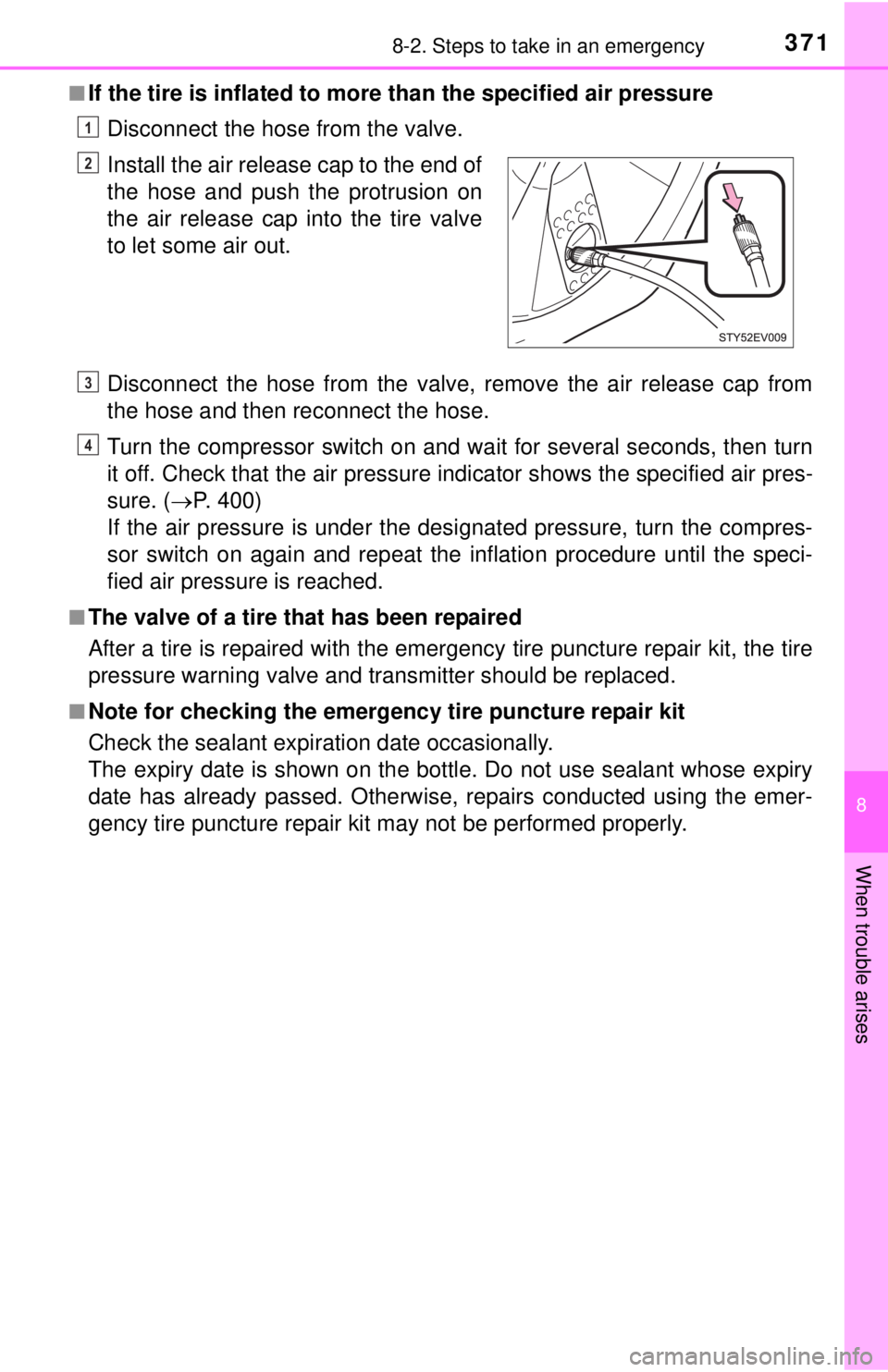
3718-2. Steps to take in an emergency
8
When trouble arises
■If the tire is inflated to more than the specified air pressure
Disconnect the hose from the valve.
Disconnect the hose from the valve, remove the air release cap from
the hose and then reconnect the hose.
Turn the compressor switch on and wa it for several seconds, then turn
it off. Check that the air pressure indicator shows the specified air pres-
sure. ( P. 400)
If the air pressure is under the designated pressure, turn the compres-
sor switch on again and repeat the inflation procedure until the speci-
fied air pressure is reached.
■The valve of a tire that has been repaired
After a tire is repaired with the emergenc y tire puncture repair kit, the tire
pressure warning valve and transmitter should be replaced.
■Note for checking the emergency tire puncture repair kit
Check the sealant expiration date occasionally.
The expiry date is shown on the bottle. Do not use sealant whose expiry
date has already passed. Otherwise, repairs conducted using the emer-
gency tire puncture repair kit may not be performed properly. Install the air release cap to the end of
the hose and push the protrusion on
the air release cap into the tire valve
to let some air out.
1
2
3
4
Page 372 of 444
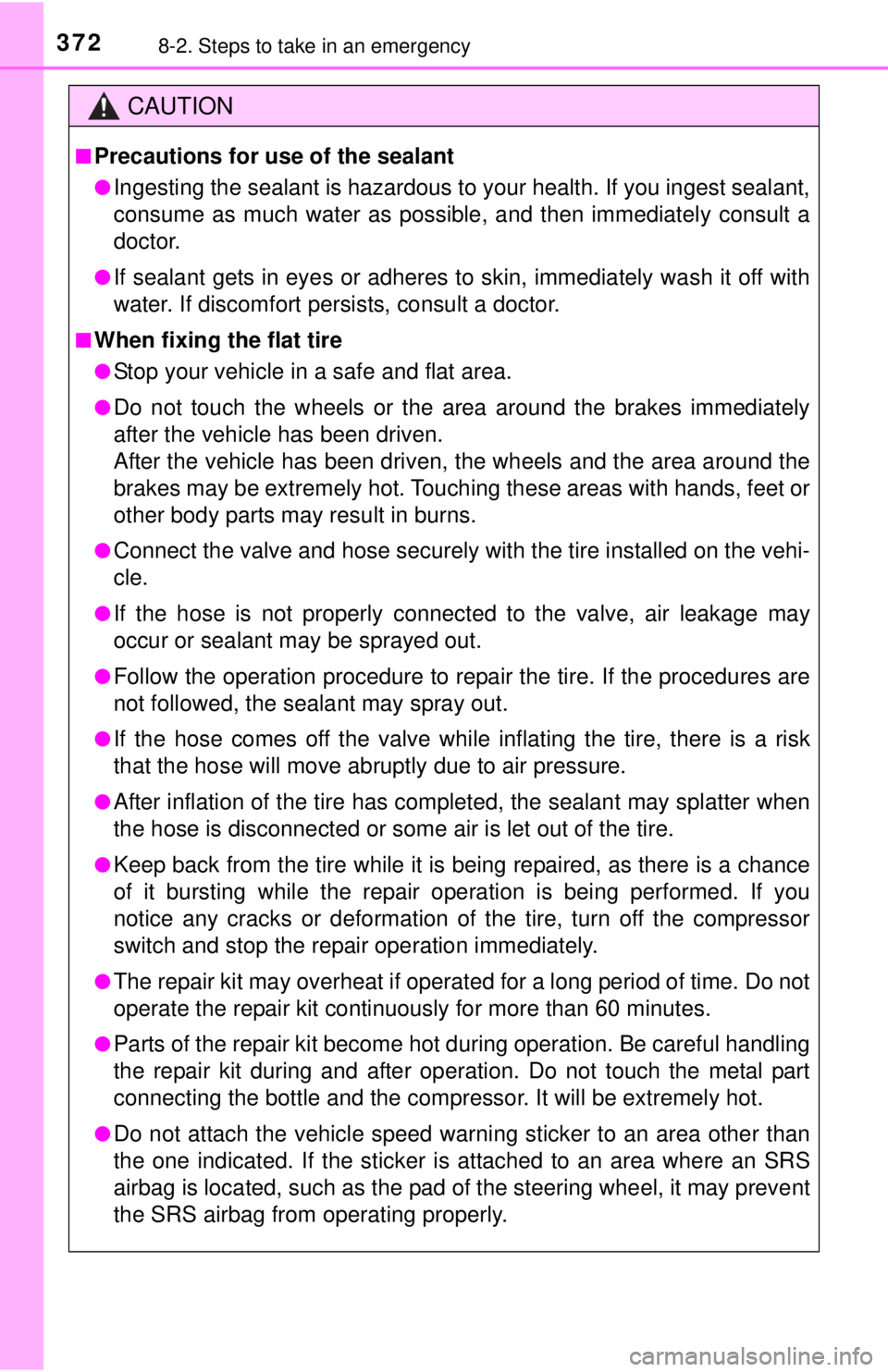
3728-2. Steps to take in an emergency
CAUTION
■Precautions for use of the sealant
●Ingesting the sealant is hazardous to your health. If you ingest sealant,
consume as much water as possible, and then immediately consult a
doctor.
●If sealant gets in eyes or adheres to skin, immediately wash it off with
water. If discomfort persists, consult a doctor.
■When fixing the flat tire
●Stop your vehicle in a safe and flat area.
●Do not touch the wheels or the ar ea around the brakes immediately
after the vehicle has been driven.
After the vehicle has been driven, the wheels and the area around the
brakes may be extremely hot. Touchi ng these areas with hands, feet or
other body parts may result in burns.
●Connect the valve and hose securely with the tire installed on the vehi-
cle.
●If the hose is not properly connec ted to the valve, air leakage may
occur or sealant ma y be sprayed out.
●Follow the operation procedure to repair the tire. If the procedures are
not followed, the sealant may spray out.
●If the hose comes off the valve while inflating the tire, there is a risk
that the hose will move abru ptly due to air pressure.
●After inflation of the tire has completed, the sealant may splatter when
the hose is disconnected or some air is let out of the tire.
●Keep back from the tire while it is being repaired, as there is a chance
of it bursting while the repair op eration is being performed. If you
notice any cracks or deformation of the tire, turn off the compressor
switch and stop the repair operation immediately.
●The repair kit may overheat if operated for a long period of time. Do not
operate the repair kit continuously for more than 60 minutes.
●Parts of the repair kit become hot during operation. Be careful handling
the repair kit during and after operation. Do not touch the metal part
connecting the bottle and the compressor. It will be extremely hot.
●Do not attach the vehicle speed warning sticker to an area other than
the one indicated. If the sticker is attached to an area where an SRS
airbag is located, such as the pad of the steering wheel, it may prevent
the SRS airbag from operating properly.
Page 373 of 444
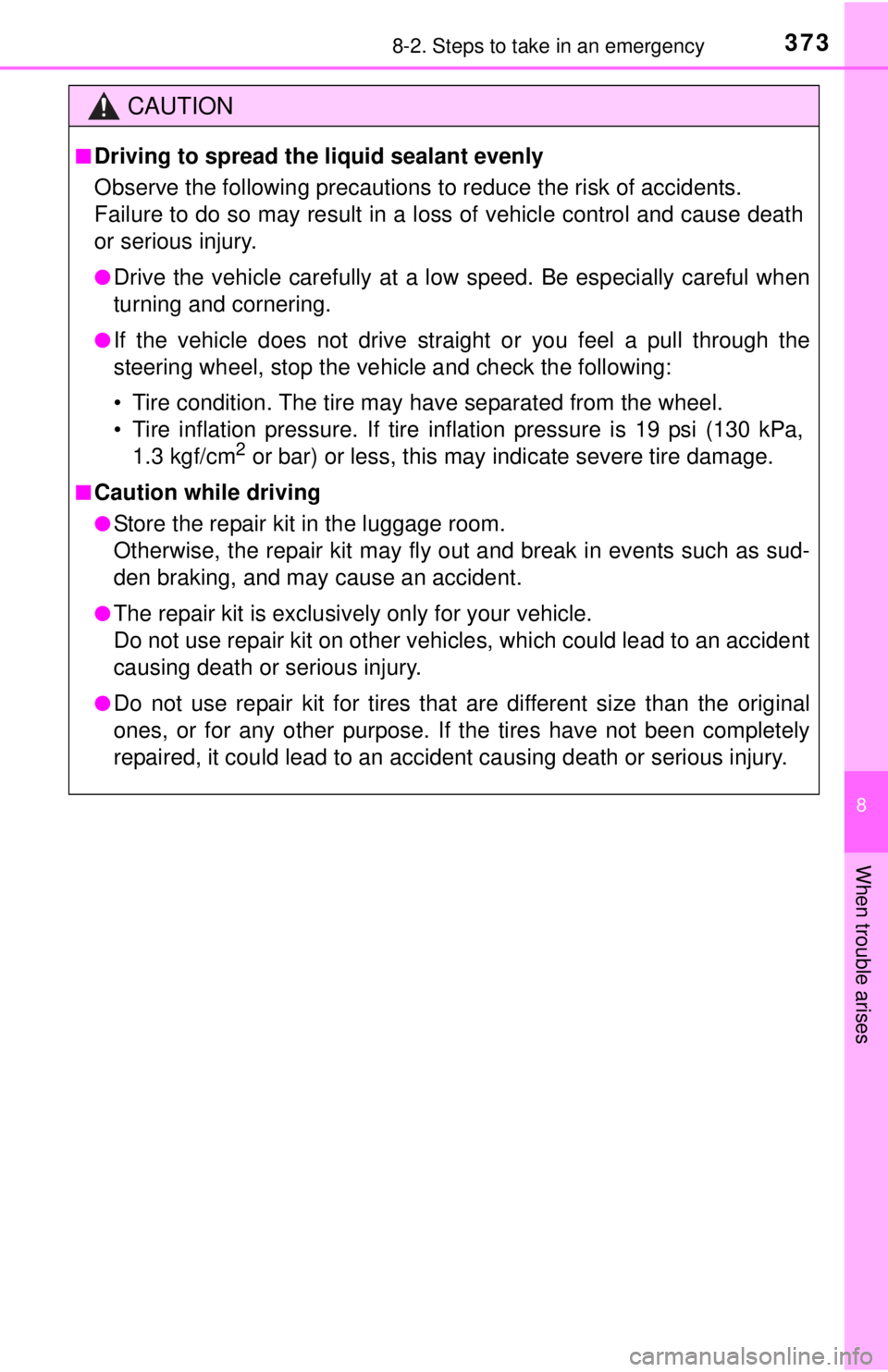
3738-2. Steps to take in an emergency
8
When trouble arises
CAUTION
■Driving to spread the liquid sealant evenly
Observe the following precautions to reduce the risk of accidents.
Failure to do so may result in a loss of vehicle control and cause death
or serious injury.
●Drive the vehicle carefully at a low speed. Be especially careful when
turning and cornering.
●If the vehicle does not drive strai ght or you feel a pull through the
steering wheel, stop the vehicle and check the following:
• Tire condition. The tire may have separated from the wheel.
• Tire inflation pressure. If tire inflation pressure is 19 psi (130 kPa, 1.3 kgf/cm
2 or bar) or less, this may indicate severe tire damage.
■Caution while driving
●Store the repair kit in the luggage room.
Otherwise, the repair kit may fly out and break in events such as sud-
den braking, and may cause an accident.
●The repair kit is exclusively only for your vehicle.
Do not use repair kit on other vehicles, which could lead to an accident
causing death or serious injury.
●Do not use repair kit for tires that are different size than the original
ones, or for any other purpose. If the tires have not been completely
repaired, it could lead to an accident causing death or serious injury.
Page 374 of 444
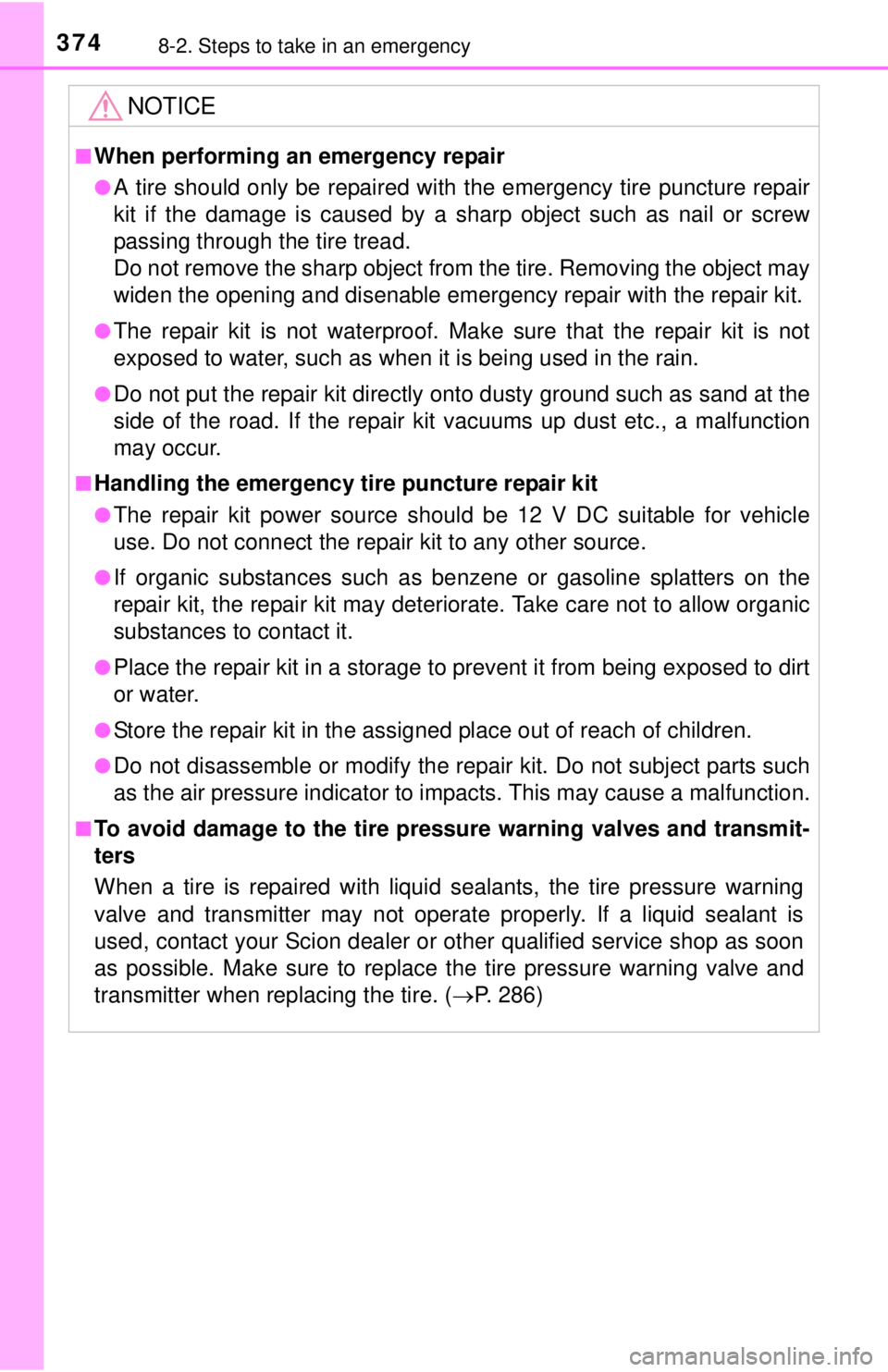
3748-2. Steps to take in an emergency
NOTICE
■When performing an emergency repair
●A tire should only be repaired with the emergency tire puncture repair
kit if the damage is caused by a sharp object such as nail or screw
passing through the tire tread.
Do not remove the sharp object from the tire. Removing the object may
widen the opening and disenable emergency repair with the repair kit.
●The repair kit is not waterproof. Make sure that the repair kit is not
exposed to water, such as when it is being used in the rain.
●Do not put the repair kit directly onto dusty ground such as sand at the
side of the road. If the repair kit vacuums up dust etc., a malfunction
may occur.
■Handling the emergency tire puncture repair kit
●The repair kit power source should be 12 V DC suitable for vehicle
use. Do not connect the repa ir kit to any other source.
●If organic substances such as benzene or gasoline splatters on the
repair kit, the repair kit may deteriorate. Take care not to allow organic
substances to contact it.
●Place the repair kit in a storage to prevent it from being exposed to dirt
or water.
●Store the repair kit in the assigned place out of reach of children.
●Do not disassemble or modify the re pair kit. Do not subject parts such
as the air pressure indicator to impacts. This may cause a malfunction.
■To avoid damage to the tire pressure warning valves and transmit-
ters
When a tire is repaired with liquid sealants, the tire pressure warning
valve and transmitter may not operate properly. If a liquid sealant is
used, contact your Scion dealer or other qualified service shop as soon
as possible. Make sure to replace the tire pressure warning valve and
transmitter when replacing the tire. ( P. 286)
Page 375 of 444
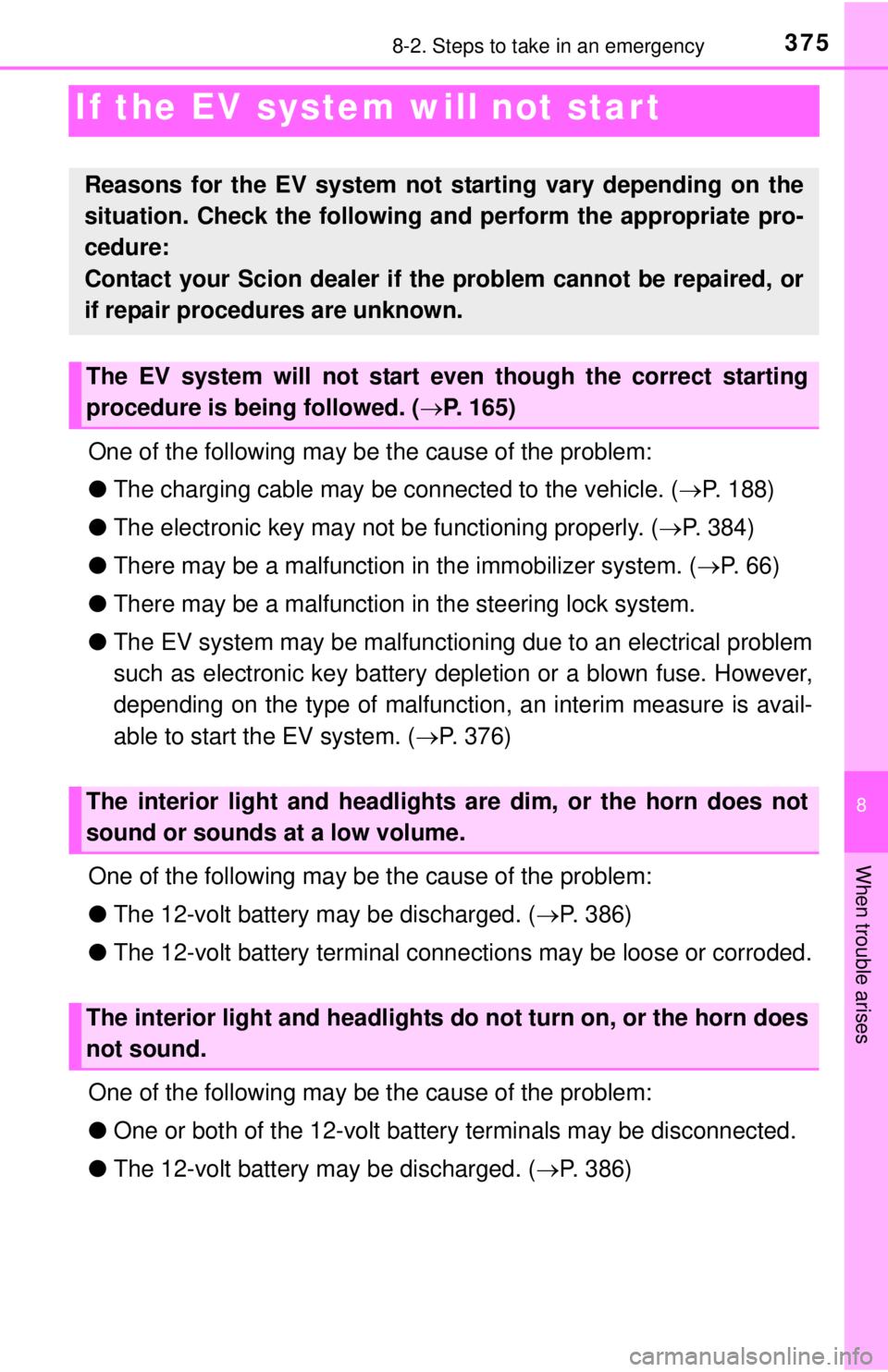
375
8
When trouble arises
8-2. Steps to take in an emergency
If the EV system will not star t
One of the following may be the cause of the problem:
●The charging cable may be connected to the vehicle. ( P. 188)
● The electronic key may not be functioning properly. ( P. 384)
● There may be a malfunction in the immobilizer system. (P. 6 6 )
● There may be a malfunction in the steering lock system.
● The EV system may be malfunctioning due to an electrical problem
such as electronic key battery depletion or a blown fuse. However,
depending on the type of malfuncti on, an interim measure is avail-
able to start the EV system. ( P. 376)
One of the following may be the cause of the problem:
● The 12-volt battery may be discharged. ( P. 386)
● The 12-volt battery terminal conn ections may be loose or corroded.
One of the following may be the cause of the problem:
● One or both of the 12-volt batter y terminals may be disconnected.
● The 12-volt battery may be discharged. ( P. 386)
Reasons for the EV system not starting vary depending on the
situation. Check the following and perform the appropriate pro-
cedure:
Contact your Scion dealer if th e problem cannot be repaired, or
if repair procedures are unknown.
The EV system will not start even though the correct starting
procedure is being followed. ( P. 165)
The interior light and headlights are dim, or the horn does not
sound or sounds at a low volume.
The interior light and headlights do not turn on, or the horn does
not sound.
Page 376 of 444
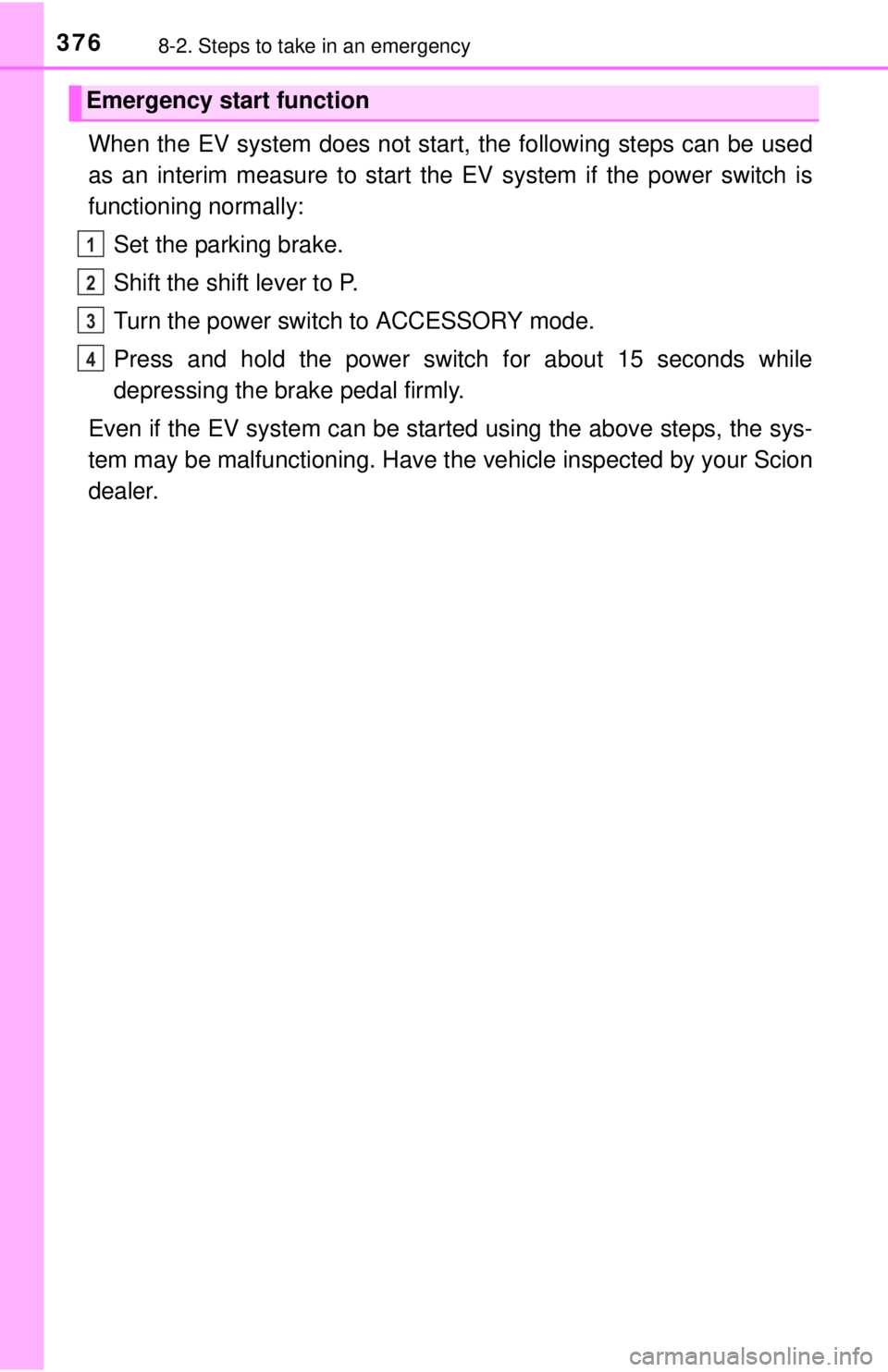
3768-2. Steps to take in an emergency
When the EV system does not start, the following steps can be used
as an interim measure to start the EV system if the power switch is
functioning normally:
Set the parking brake.
Shift the shift lever to P.
Turn the power switch to ACCESSORY mode.
Press and hold the power switch for about 15 seconds while
depressing the brake pedal firmly.
Even if the EV system can be star ted using the above steps, the sys-
tem may be malfunctioning. Have th e vehicle inspected by your Scion
dealer.
Emergency start function
1
2
3
4
Page 377 of 444
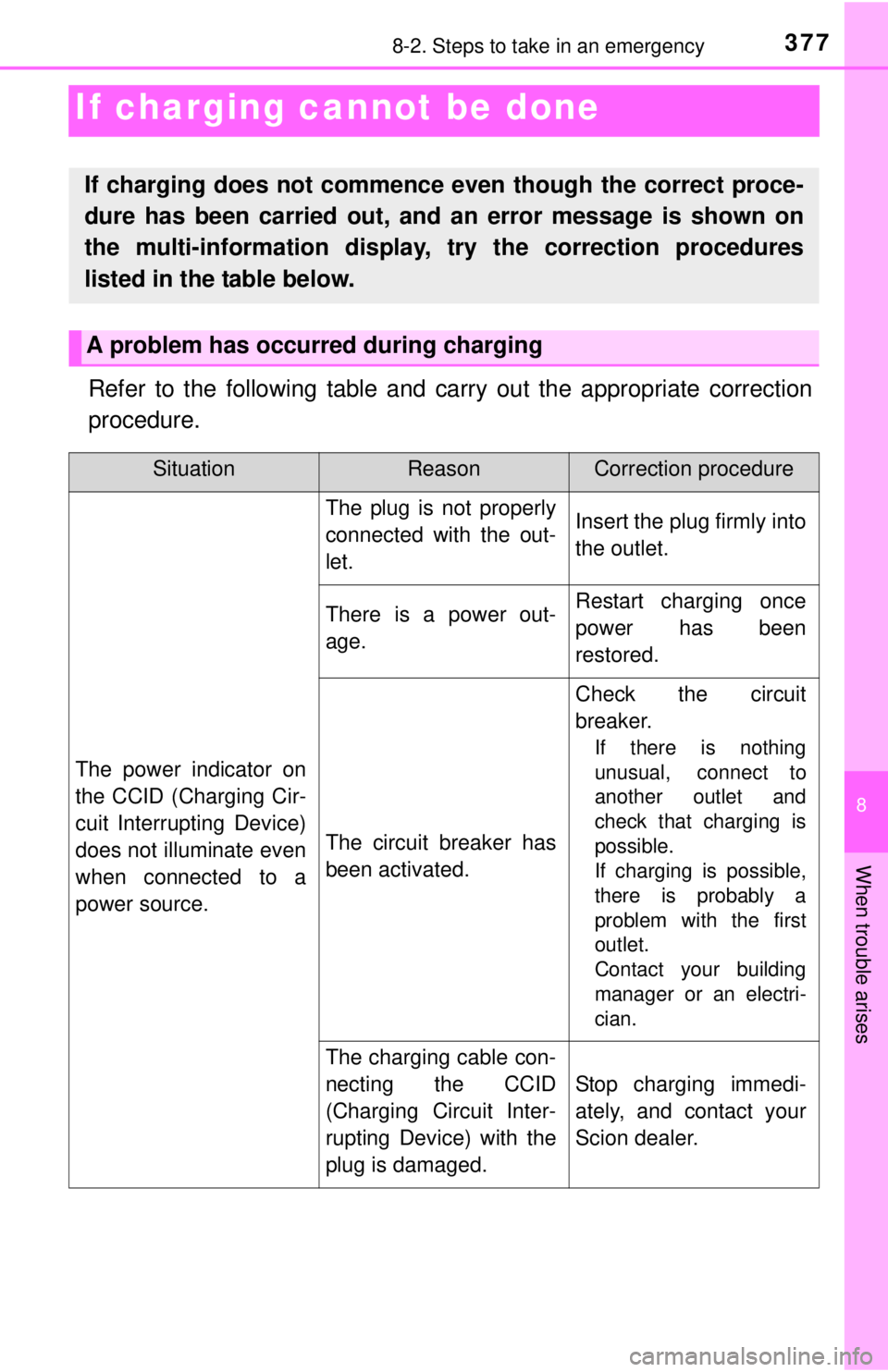
377
8
When trouble arises
8-2. Steps to take in an emergency
If charging cannot be done
Refer to the following table and carry out the appropriate correction
procedure.
If charging does not commence even though the correct proce-
dure has been carried out, and an error message is shown on
the multi-information display, try the correction procedures
listed in the table below.
A problem has occurred during charging
SituationReasonCorrection procedure
The power indicator on
the CCID (Charging Cir-
cuit Interrupting Device)
does not illuminate even
when connected to a
power source.
The plug is not properly
connected with the out-
let.Insert the plug firmly into
the outlet.
There is a power out-
age.Restart charging once
power has been
restored.
The circuit breaker has
been activated.
Check the circuit
breaker.
If there is nothing
unusual, connect to
another outlet and
check that charging is
possible.
If charging is possible,
there is probably a
problem with the first
outlet.
Contact your building
manager or an electri-
cian.
The charging cable con-
necting the CCID
(Charging Circuit Inter-
rupting Device) with the
plug is damaged.
Stop charging immedi-
ately, and contact your
Scion dealer.
Page 378 of 444
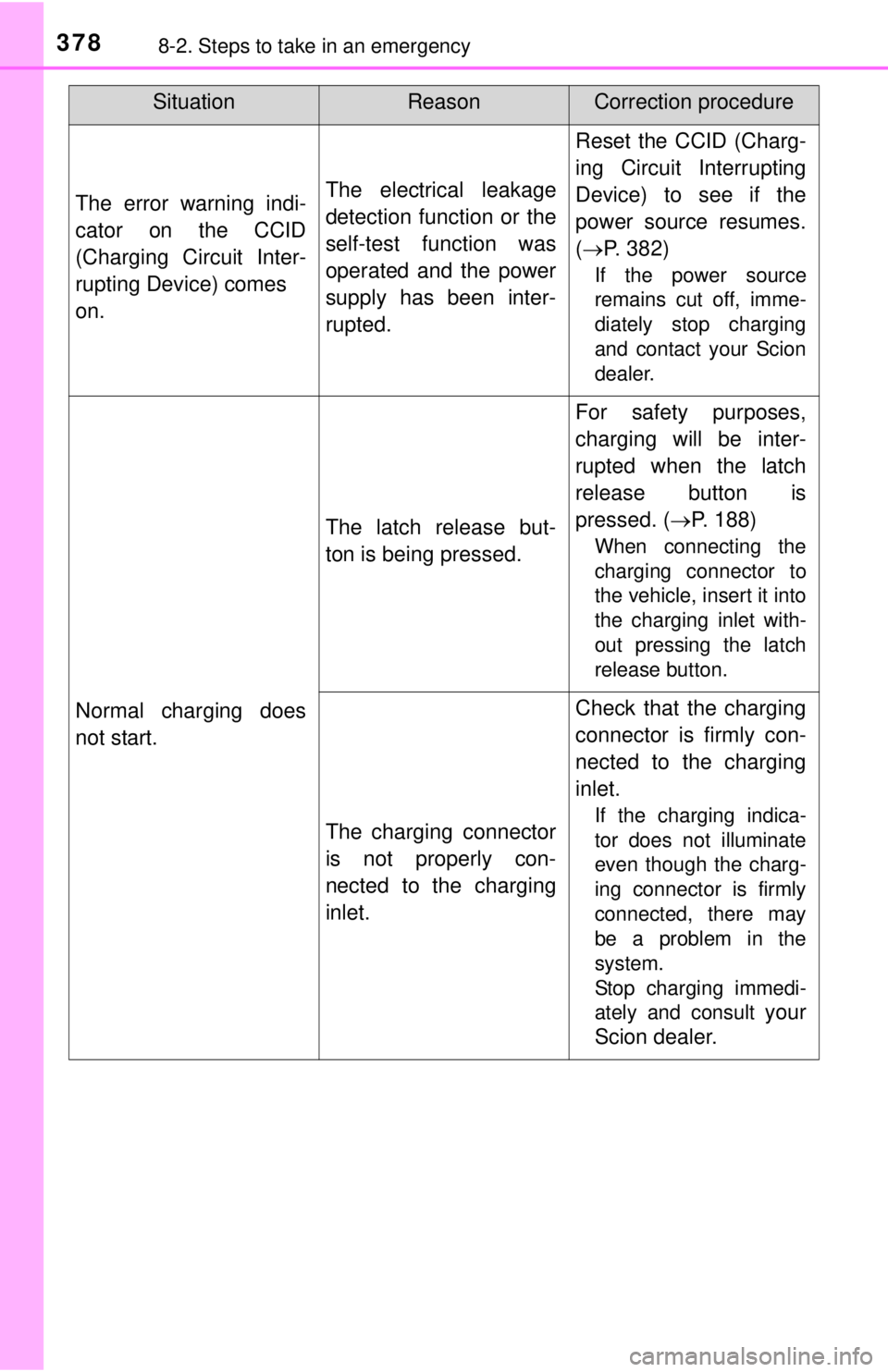
3788-2. Steps to take in an emergency
The error warning indi-
cator on the CCID
(Charging Circuit Inter-
rupting Device) comes
on.The electrical leakage
detection function or the
self-test function was
operated and the power
supply has been inter-
rupted.
Reset the CCID (Charg-
ing Circuit Interrupting
Device) to see if the
power source resumes.
(P. 382)
If the power source
remains cut off, imme-
diately stop charging
and contact your Scion
dealer.
Normal charging does
not start.
The latch release but-
ton is being pressed.
For safety purposes,
charging will be inter-
rupted when the latch
release button is
pressed. ( P. 188)
When connecting the
charging connector to
the vehicle, insert it into
the charging inlet with-
out pressing the latch
release button.
The charging connector
is not properly con-
nected to the charging
inlet.
Check that the charging
connector is firmly con-
nected to the charging
inlet.
If the charging indica-
tor does not illuminate
even though the charg-
ing connector is firmly
connected, there may
be a problem in the
system.
Stop charging immedi-
ately and consult
your
Scion dealer.
SituationReasonCorrection procedure
Page 379 of 444
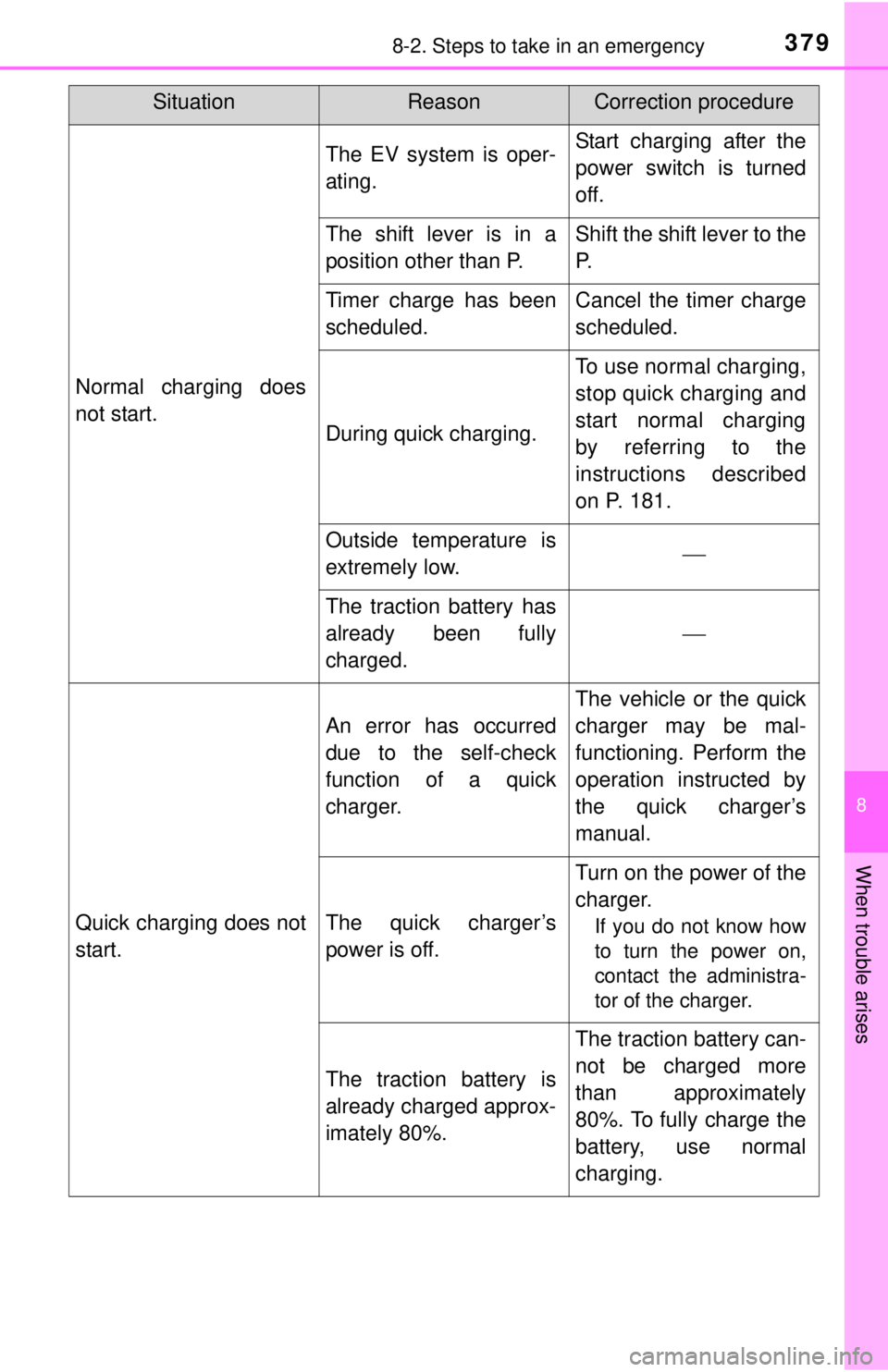
3798-2. Steps to take in an emergency
8
When trouble arises
Normal charging does
not start.
The EV system is oper-
ating.Start charging after the
power switch is turned
off.
The shift lever is in a
position other than P.Shift the shift lever to the
P.
Timer charge has been
scheduled.Cancel the timer charge
scheduled.
During quick charging.
To use normal charging,
stop quick charging and
start normal charging
by referring to the
instructions described
on P. 181.
Outside temperature is
extremely low.
The traction battery has
already been fully
charged.
Quick charging does not
start.
An error has occurred
due to the self-check
function of a quick
charger.
The vehicle or the quick
charger may be mal-
functioning. Perform the
operation instructed by
the quick charger’s
manual.
The quick charger’s
power is off.
Turn on the power of the
charger.
If you do not know how
to turn the power on,
contact the administra-
tor of the charger.
The traction battery is
already charged approx-
imately 80%.
The traction battery can-
not be charged more
than approximately
80%. To fully charge the
battery, use normal
charging.
SituationReasonCorrection procedure
Page 380 of 444
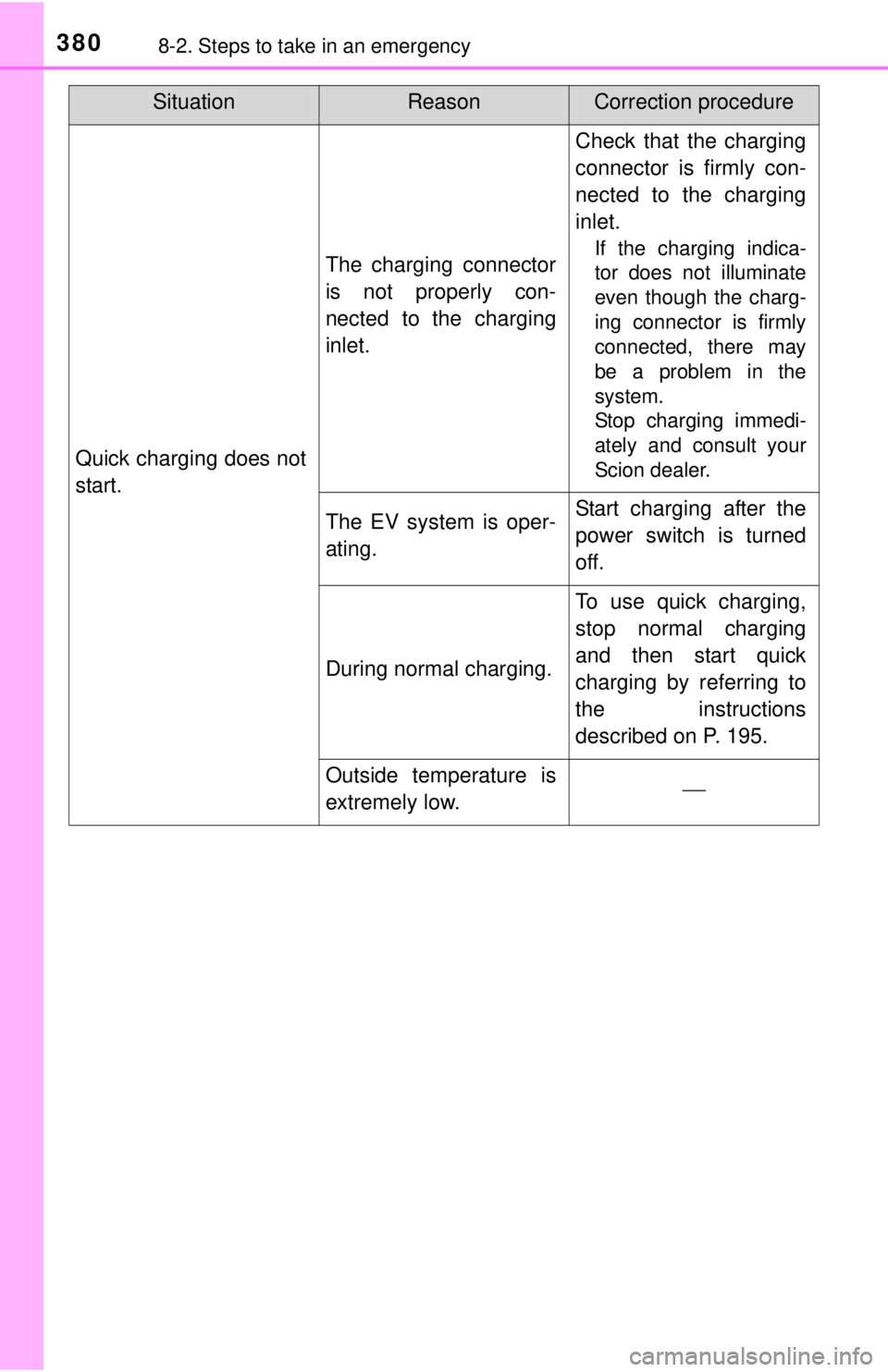
3808-2. Steps to take in an emergency
Quick charging does not
start.
The charging connector
is not properly con-
nected to the charging
inlet.
Check that the charging
connector is firmly con-
nected to the charging
inlet.
If the charging indica-
tor does not illuminate
even though the charg-
ing connector is firmly
connected, there may
be a problem in the
system.
Stop charging immedi-
ately and consult your
Scion dealer.
The EV system is oper-
ating.Start charging after the
power switch is turned
off.
During normal charging.
To use quick charging,
stop normal charging
and then start quick
charging by referring to
the instructions
described on P. 195.
Outside temperature is
extremely low.
SituationReasonCorrection procedure